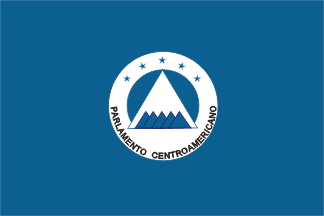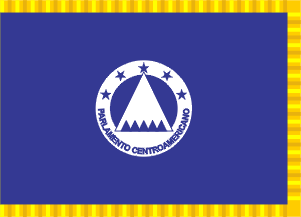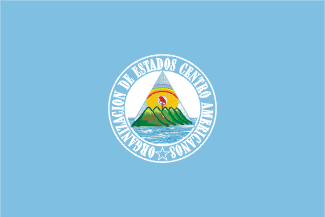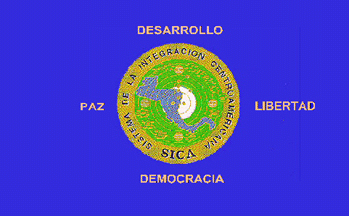
image by Jaume Olle', 17 October 2004

Last modified: 2005-10-08 by dov gutterman
Keywords: america | central america | panama | honduras | nicaragua | guatemala | el salvador | odeca | belize | parliament | sica |
Links: FOTW homepage |
search |
disclaimer and copyright |
write us |
mirrors
See also:

image by Jaume Olle', 17 October 2004

Ceremonial Flag
image by Juan Manuel Gabino Villascan, 6 September 2002
Here is a photo of the
flag. You can see the seal at
<www.pentanet.com.mx> (defunct).
Fred Drews, 9 September 1999 and Alvin
Helms, 2 November 1999
Early this week (September 3-4) Mexico summoned the leaders of
the Central-American Parliament, plus those from Belize and
Panama. In the meeting room appeared the flag of the seven
participant countries, in between them those of Mexico and of the
Central American Parliament (CAP). The meeting was broadcasted by
the cable-channel "Canal de Congreso". The CAP's flag
is plain dark blue with the emblem in the center. The emblem
consists of a white ring with five blue five-pointed stars in the
upper hemi-circle and the body's name in capital letters also in
blue on the lower one. On the ring, centered, six triangles, one
in white and bigger than the others. The remainder five, aligned
in the largest one's base, are blue. The triangles stands
for volcanoes, geographic feature of Central-America. There are a
Blue flag as hoisted jointly to the other during the Mexico's
meeting, as well a Blue flag with gold fringe as appeared on the
presidium table during the meeting.
Juan Manuel Gabino Villascan, 6 September 2002
Costa Rica and Belize are not not a members of the Central
American Parliament. There are only 6 member states: El Salvador,
Guatemala, Honduras, Nicaragua, Panama and Dominican
Republic. Also there are 3 observant members: Puerto Rico,
Mexico and Taiwan. As per their website <www.parlacen.org.gt >.
Doel A. Rodríguez, 27 November 2002
The letters on the flag must be black.
Jaume Olle', 17 October 2004
The Flag

image by Juan Manuel Gabino Villascan, 19 September 2002
The flag of Organización de Estados Centroamericanos (ODECA)
/ Organization of Central American States. Image can be found in
"Flaggor från hela världen" by Mauro Talocci.
Marcus Wendel , 4 September 1999
The flag and emblem of the Central American States
Organization are according to brochures provided by the Costa
Rica embassy to Mexico.
Juan Manuel Gabino Villascan, 19 September 2002
Organization of Central American States is presented in 1995
issue of l'Album. Nothing of the sort appears in Album 2000.
However, the image above and that in 1995 Album are slightly
different (in colouring in the emblem and level of details).
Anyway, if I understood rigthly this organization is no longer
active and was replaced by the Parlamento Centroamericano which
uses an other flag. Regarding the ODECA flag and emblem, both
drawing by Juan Manuel, they also differ in colouring (especially
of the ring containing the text). Is this by purpose?
Željko Heimer, 14 December 2003
See also: <www.casapres.gob.sv>
Coat of Arms
org.gif)
image by Juan Manuel Gabino Villascan, 19 September 2002
Coat of Arms of the Organization of Central American States.
this organization has been replaced by the Central American
Parliament and the SIECA. Also here is an image of its flag.
Fred Drews , 8 September 1999

image by Fred Drews , 24 May 2000
sie.gif)
Coat of Arms
image contributed by Fred Drews , 9 September 1999
I am in El Salvador and have found that the flag is not of the
Secretariat for Central American Economic Integration (SIECA) but
the flag of the Secretariat for Central American Integration
(SICA). The Secretaría de Integración Económica
Centroamericana (SIECA) is a subdivision of SICA. I went today to
visit the building and has the flag flying in front of it and it
says SICA in front of it.
by Fred Drews, 20 October 2000
From <www.infoplease.com>:
"Central American Common Market (CACM), trade organization
started in 1960 by a treaty between Guatemala, Honduras,
Nicaragua, El Salvador, and later Costa Rica. By the mid-1960s
the group had made advances toward economic integration, and by
1970 trade between member nations had risen more than tenfold
over 1960 levels. During the same period, imports doubled and a
common tariff was established for 98% of the trade with nonmember
countries. In 1967, at the conference of American presidents at
Punta del Este, Uruguay, it was decided that CACM, together with
the Latin American Free Trade Association, would be the basis for
a comprehensive Latin American common market. However, by the
early 1990s little progress toward a Latin American common market
had been made, in part because of internal and internecine
strife, in part because CACM economies were competitive, not
complementary. Nonetheless, CACM has been judged more successful
at lowering trade barriers than other Latin American groupings.
Francisco Santos, 7 August 2003